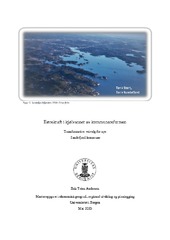Bærekraft i kjølvannet av kommunereformen: Transformative veivalg for nye Sandefjord kommune
Master thesis
Permanent lenke
https://hdl.handle.net/1956/22655Utgivelsesdato
2020-06-17Metadata
Vis full innførselSamlinger
- Master theses [144]
Sammendrag
The municipality reform in 2020 had a large impact on the geographical appearance and official functioning of many municipalities in Norway. This master thesis examines the effects this reform had on manoeuvring capacity, in respects to ability and aptitude, with the local sustainability efforts in the newly formed municipality Sandefjord studied. Sandefjord was chosen as the case study due to its amalgamation prior to the reform in 2020 with the neighboring municipalities Andebu and Stokke in 2017. In this thesis are some of the causes and effects that the amalgamation had on the municipality studied, before it takes a more theoretical turn and discusses some general strategies that can be used to interpret the sum of the results that Sandefjord experienced. The main topics concerning the manoeuvring capacity and efficient sustainability efforts are first revealed through the primary data shaped from local informant interviews as qualitative sources. Quite a few interesting aspects were brought to light concerning the contextual factor effects on the manoeuvring capacities of the municipality Sandefjord in the aftermath of the fusion process. Furthermore the sustainability topic studied in relation to the role and effect of the state’s framework in respect to the Norwegian Planning and Building Act (PBL) and National Expectations (NF) and their grasp on the situation in Sandefjord were in the autumn of 2019 when the interviews were conducted. In the discussion are several theories connected through a relational understanding and constructive approach. The goal of the discussion was to break down some core elements of the society as a system in search of how Norwegian municipalities could improve their manoeuvring capacities (ability, aptitude) and make their sustainability efforts more efficient moving forward. To manage this are complex theories used to showcase how different components and actors both indirectly and directly affect one another through multiple complex networks in Norwegian society. The understanding is linked to human geography through a relational understanding. In the analysis the informant’s experiences of the changes that happened to Sandefjord’s manoeuvring capacity in the aftermath of the amalgamation are revealing the main barricade was economical and mostly caused by contextual factors the old municipalities brought with them. This led to limited manoeuvring capacity for the new municipality, which in turn caused confined sustainability efforts at the local level. The discoveries from the discussion, which are built on a mixture of theories connected to human geography, argue that municipalities could experience a higher manoeuvring capacity after internal reorganisation and restructuring of the administration. This could potentially secure more collaboration and governance across different subsystems within the administration due to the re-establishing of multiple intern cultures. Another strategy that this thesis explores is called facilitated chaos. Here the municipalities focus on a facilitation of diversity in public places though variated, attractive and multi – purpose friendly areas which through the inhabitants use generates local vitality, sense of place and belonging. This strategy can, as argued in this thesis, turn the inhabitants into a resource for the municipality which can free up some manoeuvring capacity and raise the efficiency of the local sustainability efforts if implemented with such a goal.
